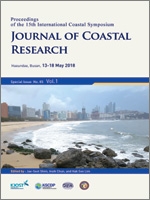Rollnic, M.; Costa, M.S.; Medeiros, P.R.L., and Monteiro, S.M., 2018. Tide Influence on Suspended Matter in an Amazonian Estuary. In: Shim, J.-S.; Chun, I., and Lim, H.S. (eds.), Proceedings from the International Coastal Symposium (ICS) 2018 (Busan, Republic of Korea). Journal of Coastal Research, Special Issue No. 85, pp. 121–125. Coconut Creek (Florida), ISSN 0749-0208.
The aim of this study is to check which tidal component (dispersive or diffuse) dominates suspended particulate matter transport (SPM) in the Mojuim River estuary. This estuary comprises the eastern sector of the Amazon coast, characterized by mangrove-vegetated tidal flats. Measurements of current intensity and direction, SPM, and tide level over a tidal cycle (13 h) were performed in a section of the lower estuary. Samplings were conducted in March (wet season) and September (dry season), 2014, during spring tide. The resulting transport and relative contribution of advective transport (SPM diffusion and dispersion) were calculated. Mojuim estuary has a macrotidal regime, with mean height of 4.9 m during spring tide and 3.2 m during neap tide. As it is a shallow environment, the water column is homogeneous, and hydrological parameters do not significantly vary along the water column. SPM ranged from 12 to 92 mg.L−1 during dry season and from 20.4 to 94.8 mg.L−1 during wet season. The highest SPM concentrations occurred during ebb tide, and this determined the maximum instantaneous transport, both during wet season (127.8 kg.s−1) and dry season (159 kg.s−1). This estuary is characterized as an exporter environment. During dry season, it had a residual transport of 4.1 kg.s−1 and a total transport of 191.9 tons downstream of the estuary. However, during wet season, it showed an inversion in advective transport due to equinoctial tidal influence, which caused a higher tidal prism thus resulting in a residual transport of 1.92 kg.s−1 and a total transport of 90 tons upstream of the estuary. The dominant SPM transport component downstream of the estuary was river discharge, whereas SPM transport upstream of the estuary was dominated by Stokes Transport.





